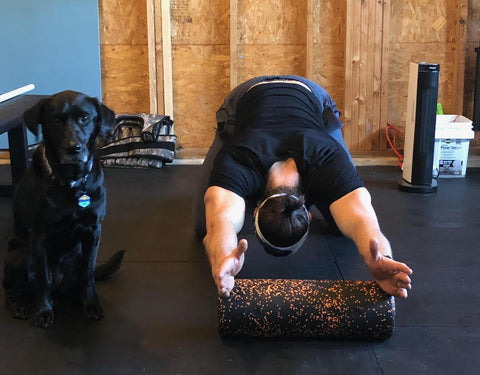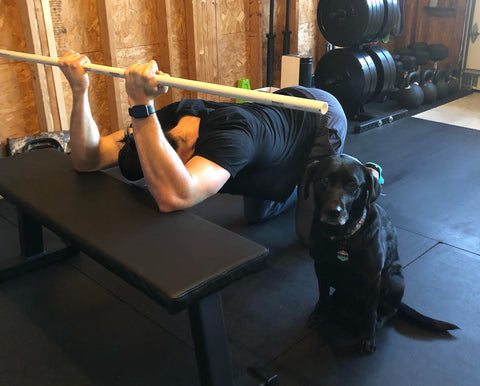Author: Matt Shaw (@mrshaw319)
Cartwheels, speed pitch, horseshoes...what do these all have in common? Just one thing - they’re all impossible without one of the most important joints in your body: the shoulder. Physician Assistant and Earth Fed Elite Matt Shaw takes us through the various steps of identifying and treating shoulder pain.
The shoulder is the most mobile joint in the body. While considered a ball and socket joint, it is more like a golf ball sitting on a tee. The shallow socket (glenoid) is designed to allow optimal mobility of the joint. To support this, a variety of soft tissue structures work together to maintain stability. Due to the complexity of the shoulder, it is susceptible to a variety of injuries. With proper maintenance, many of these injuries can be avoided. We all know injuries are no fun; so let’s give those shoulders some love.

A base knowledge of anatomy will help identify the cause of pain and what to do to prevent further decline. The rotator cuff is a group of four muscles (supraspinatus, infraspinatus, teres minor, and subscapularis) that attach to the humeral head, contracting and relaxing, as a unit to keep the “golf ball on the tee.” These muscles also play a role in rotational movements and raising the arm. The labrum is a structure that wraps around the glenoid to function as a bumper for additional stability and serves as an attachment site for one of the biceps tendons. The labrum, along with the capsule, supports the shoulder to avoid dislocations. Finally, the deltoid is the large muscle that acts as the powerhouse of the shoulder for overhead movements and initiating raising the arm away from the body.

What can go wrong? Shoulder injuries are common from elite athletes to senior citizens. The cause of injury can result from acute trauma, overuse, mobility deficits, stability deficits or degeneration over time. Common injuries include rotator cuff tendonitis, rotator cuff tear, labral tear, biceps tendonitis or tear, bone damage to humeral head or glenoid, deltoid strain, to name a few. It is important to identify the underlying cause to establish a treatment plan to prevent worsening of the issue. If you are experiencing noticeable weakness or history of dislocation, seek the advice of your local sports medicine provider.
Fortunately, many shoulder injuries can be prevented with proper maintenance work. By being nice to our shoulders and performing appropriate exercises, the shoulder will be prepared to handle everything from activities of daily living, athletics and even the most technical lifts under heavy loads.
-
Warming up the shoulders, upper back muscles and thoracic spine before activity is critical. Whether performing overhead lifts, throwing, swimming or even swinging a golf club, the shoulder needs to wake up. It is important to comfortably reach positions without loads before adding weight to the equation. The images below demonstrate good stretches to perform before overhead lifts. Rotational stretches would be beneficial before activities such as throwing, wrestling and various other activities. Always keep in mind; static stretches are not designed to be painful. Consistent gentle stretches over time will lead to improved mobility.


- Explore a variety of positions and angles when performing exercises. For example, work both internal and external rotation, raises in forward, lateral and angled positions and overhead movements. By mixing up training patterns, the shoulders will be less susceptible to injury. Resistance bands are fantastic tools that provide smooth and increasing levels of tension.
- Do not overlook stability training for strength work. Isolated holds are exercises designed to resist movement. Certain muscles are not designed to push significant weight, but they are critical in maintaining stability while the bigger muscles perform the action of moving the load. The rotator cuff is a prime example. When properly trained, it can stabilize the humeral head when lifting heavy loads and performing violent movements such as Olympic lifts and high velocity throwing. Examples of exercises include 3-5 second pauses when performing arm raises, rotational resistance, overhead carries and overhead press with inverted kettle bells.
- Gradually build load and volume to allow body to recover, adapt and grow. Whether it is pitches thrown or weights moved, it takes time to safely advance. Keep in mind, it is more important to make long term and consistent progressions than quick jumps that result in avoidable injuries causing gaps in your training schedule. Consistency is key!
Remember, shoulders are our friends. They give us the ability to perform functional activities and compete at elite levels. Maintaining strength, stability and mobility of our shoulders is a never-ending process. A proper nutrition and supplement routine will help the body build and repair. It is critical to fulfill your daily requirements of vitamins, minerals and protein with supplements such as Armor, Forty Winks, Whey and Collagen. There is no progress without rest and recovery. As always, when pain worsens or fails to improve, please seek the help of a medical professional to guide you in the right direction.
